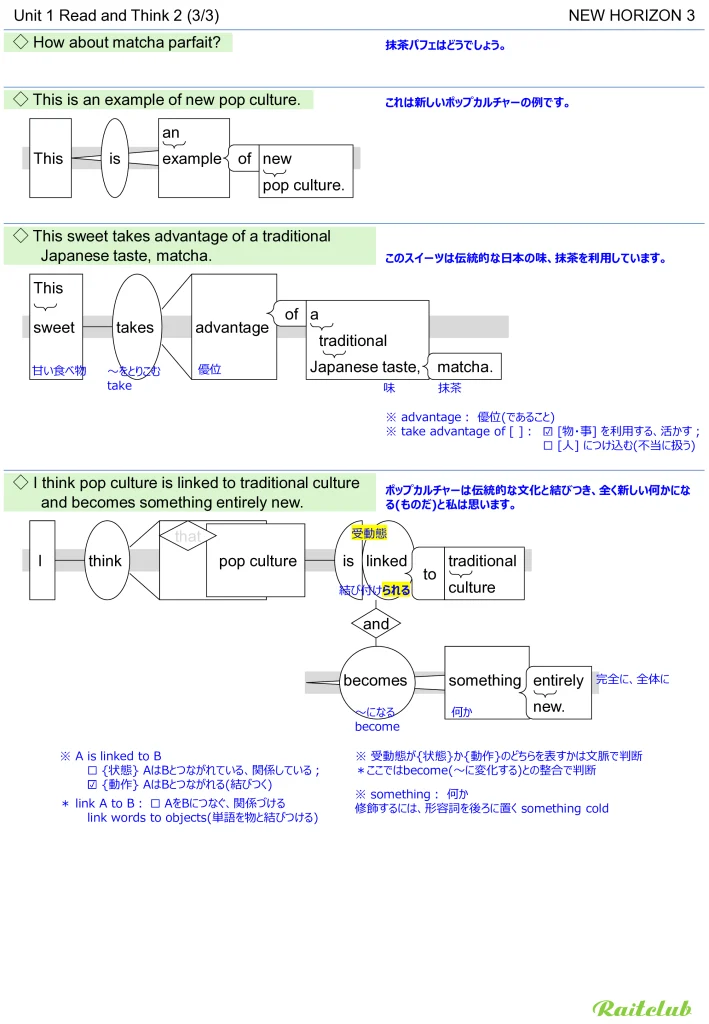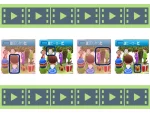中学3年生教科書 New Horizon 3 (ニューホライズン 3年) 2025~28年度用 Unit 1: What is special about Japanese pop culture? の重要文法と、本文・和訳・英文見える化チャートです。
英文見える化チャートは、英語の「意味理解」を視覚的にサポートするツールです。習得を促進する音声付きです。音読活動などで活用することで英語を身に着けるのを支援します。
ポイント解説付きなので、定期テスト対策として、単語の意味・用法や、文法・文構造の確認にも使えます。
なおこのページでは英語のみの音声も聞けます。リスニングやシャドウイングなどでお使いいただけます。
重要文法
現在完了形(経験用法) < have + 過去分詞>
~したことがある
➡ I have watched Japanese anime many times.
目的語と補語をとる動詞 < 動詞 + A + B>
A=BであるようにAを ~する
*動詞は make, call など
➡ They make me excited.
目的語を2つとる動詞 < 動詞 + (人) + (that 節)>
(人) に (that 節であること) を ~する
*動詞はshow, tell, teachなど
➡ Anime shows us that Japanese pop culture comes from traditional culture.
本文・和訳・チャート
音声リスト
※ バックグラウンド再生もできます
以下の各パート内の音声は速度調整や個別にループ再生もできます
Unit 1 Part 1
◇ The foreign tourists are interested in ....
(それらの)外国人観光客は … に興味があります。
(設定: 外国人観光客へのインタビュー結果のまとめ)
※ the ~: {文脈・状況から皆が特定できるものに言及する時} (その)~ *インタビューされた観光客たちをさす
◇ Anime and Manga
アニメやマンガ
◇ Food
食べ物
◇ Fashion
ファッション
◇ Shrines and Temples
神社や寺
◇ Martial Arts
武道
◇ Other
その他
◇ [Comments]
[コメント]
◆ 1. I have watched Japanese anime many times, so I’m excited to go to an anime museum in Tokyo.
私は日本のアニメを何回も見たことがあります、なので東京のアニメ博物館に行くことにわくわくしています。
◆ 現在完了形 < have + 過去分詞>
今とつながる過去の事に言及
*完了形(perfect): 動作・状態が完了・完全((今も)壊れていない)
※ 主語が三単現なら < has + 過去分詞>
◆ 現在完了形(経験用法)
「~したことがある」 ✓once:1回 ✓twice:2回 ✓three times:3回 ✓ever:今までに ✓never:一度も~ない ✓before:以前に などと
※ 不定詞(副詞用法): ☒ {感情などの原因} ~して Nice to meet you.
◇ 2. I love Japanese food, so I came here to eat many regional dishes.
私は日本の食べ物が大好きです、なのでたくさんの、地方の料理を食べるためにここに来ました。
※ 不定詞(副詞用法): ☒ {動作の目的} ~するために
※ regional: 地域の *region: 地域(広め) *area: 地域
*local: {住んでいる・話題にしている}地域の、地元の
※ local dishes とすると現在地や話している地域の郷土料理
◆ 3. I have never been to a Japanese shrine, so I want to visit some here.
私は一度も日本の神社に行ったことがありません、なのでここでいくつか訪れたいです。
◆ 現在完了形の否定文 < have/hasの後に not を置く>
経験用法では not の代わりに ✓never:一度も~ない もよく使われる
※ been: be の過去分詞 訪問する・旅行するの意味でも使われる
※ some: ☒ いくつかの人・物(言及対象が明らかなら some は代名詞として使える)/ ☐ いくつかの some shrines
音声(英語/習得用)
| ♪ 英語の音声: | |
| 1回再生 | |
|---|---|
| ループ再生 | |
| ♪ 習得用の音声(英⇒日を区切りごと): | |
| 1回再生 | |
|---|---|
| ループ再生 | |
英文見える化チャート 1/2
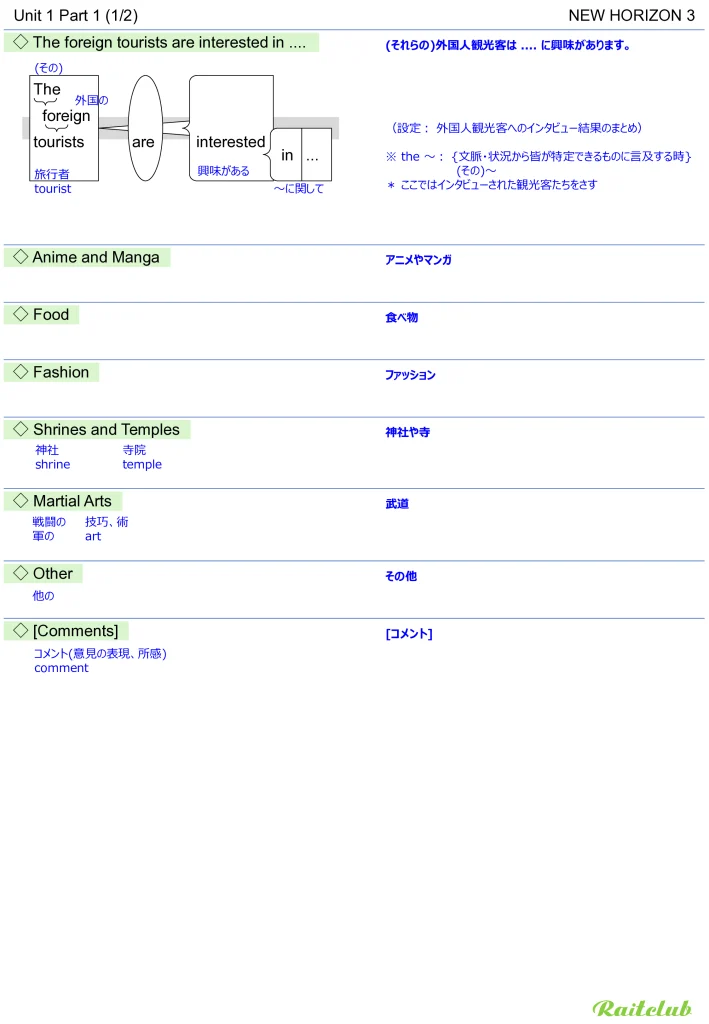
英文見える化チャート 2/2
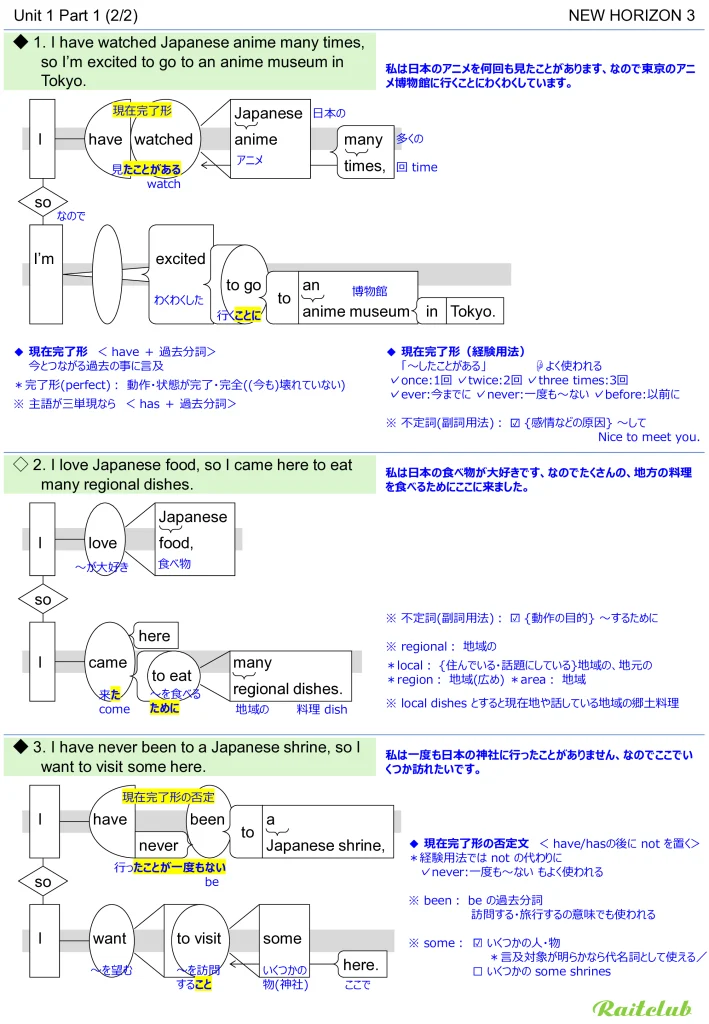
Unit 1 Part 2
◇ I’m surprised by these results.
私はこれらの結果に驚いています。
◇ Japanese pop culture is so popular among foreigners.
日本のポップカルチャーは外国人の間でとても人気があります。
※ among [ ]: [人・物の集団] の中で、間で
◇ Right. I like watching anime, too.
その通りです。私もアニメを見るのが好きです。
◇ I sometimes use anime to learn Japanese.
私は時々、日本語を学ぶためにアニメを使います。
◇ Oh, really?
あら、本当に?
◆ Have you ever watched Pokémon?
あなたは今までにポケモンを見たことがありますか?
◆ 現在完了形の疑問文 <主語と have/has の順序を入れ替える>
経験用法では ✓ever:今までに などもよく使われる
◇ It’s my favorite.
それは私の一番好きなものです。
※ favorite: ☐ 一番好きな/ ☒ 一番好きなもの * most favorite とはふつう言わない(カジュアル場面や強調表現ならあり)
◇ Yes, I have.
はい、あります。
◇ I’ve watched it many times.
私はそれを何回も見たことがあります。
※ I’ve: I have の短縮形 you’ve, we’ve, they’ve も同様
*he has なら he’s he is の短縮形と同じなので注意 she’s, it’s も同様
◇ That’s nice to hear!
そう聞いてうれしいです!
※ 不定詞(副詞用法): ☒ {感情などの原因} ~して Nice to meet you.
◆ Have you been to an anime event in Japan?
あなたは日本のアニメ・イベントに行ったことがありますか?
◇ No, I haven’t.
いいえ、ありません。
◇ Really? Anime events are so much fun.
本当に? アニメ・イベントはとてもおもしろいです。
※ fun: ☒ {不可算} おもしろいこと/ ☐ おもしろい a fun way(おもしろい方法)
×Anime events are very fun. とはいわない
= Anime events are a lot of fun.
音声(英語/習得用)
| ♪ 英語の音声: | |
| 1回再生 | |
|---|---|
| ループ再生 | |
| ♪ 習得用の音声(英⇒日を区切りごと): | |
| 1回再生 | |
|---|---|
| ループ再生 | |
英文見える化チャート 1/2
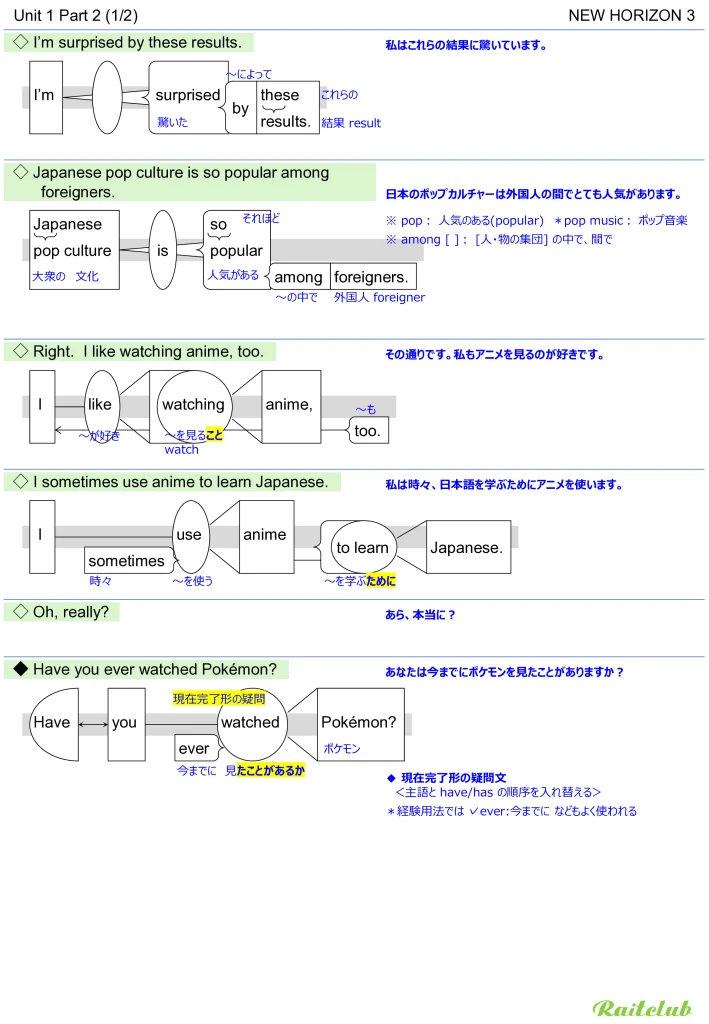
英文見える化チャート 2/2
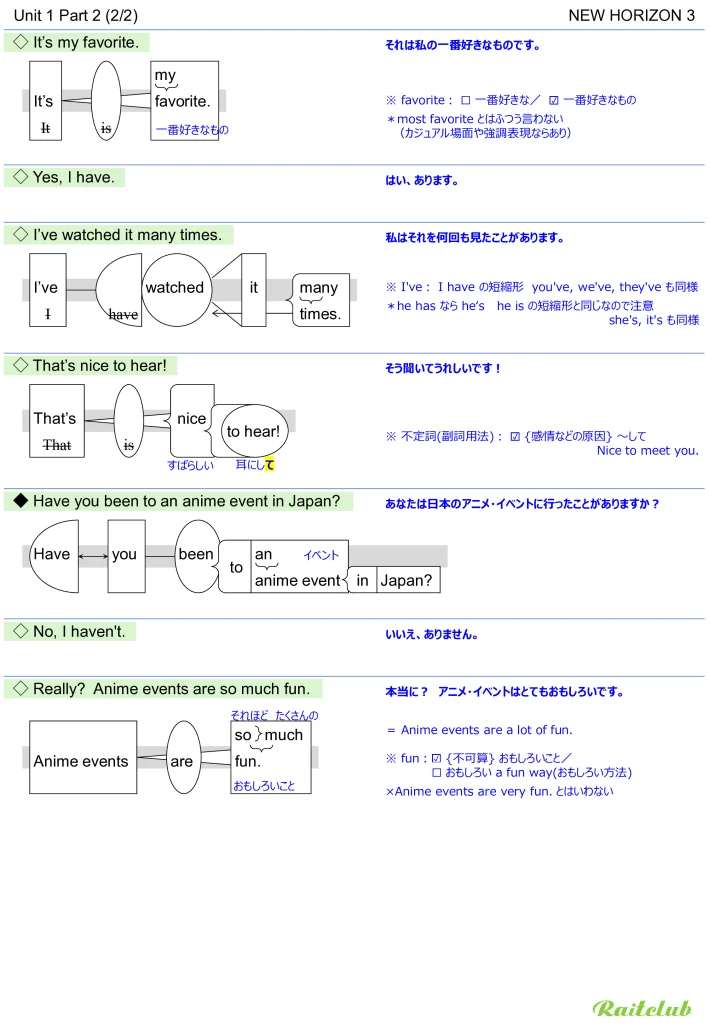
Unit 1 Read and Think 1
◇ Anime Goes Global
アニメが世界的になる
※ go ~: ☒ ~の状態になる、に進展する before things go bad(物事(状況)が悪くなる前に)
◇ There are many anime fans around the world.
世界中に多くのアニメファンがいます。
※ around [ ]: ☒ [場所など] のあちこちに、☐ の周りに jog around the pond、☐ の辺りに live around here
◆ What makes anime so popular in other countries?
何がアニメを他の国でそれほど人気にしているのでしょうか。
◆ 目的語と補語をとる動詞 < 動詞 + A + B>
A=B であるように Aを~する * 動詞は make, call など
※ make A B: A を B にする
◇ One reason is that the stories have various genres, such as adventure, sports, and history.
1つの理由は、物語にさまざまなジャンルがあるからです、冒険、スポーツ、歴史のような。
※ such as ~: {例をあげて} ~のような
◇ Both children and adults enjoy watching anime.
子どもと大人の両方がアニメを見るのを楽しみます。
※ both A and B: A と B の両方とも
◇ I especially love sports stories.
私は特にスポーツの物語が大好きです。
◆ They make me excited!
それらは私をわくわくさせます。
◇ Another reason is the quality of the animation and the drawings.
もう1つの理由はアニメーション(動画)や描画の品質です。
※ the quality of …: < the ~ + 前置詞句など>
{~の意味範囲を、前置詞句などで限定(特定)する時}
※ the animation など the で「アニメ作品(全体)の」動画であることを明示(ないと動画 一般への言及→文脈からアニメのこととわかるのでほぼ同じ意味に)
◇ They are so delicate.
それらはとても繊細です。
※ delicate: ☐ 壊れやすい、扱い注意の a delicate balance between A and B(微妙なバランス); ☐ 魅力的な、優美な delicate fingers(きゃしゃな指); ☒ 細部にこだわった、精巧な
◇ You can really understand the feelings of each character.
人々はそれぞれのキャラクターの気持ちを本当に理解できます。
※ You: {不特定の一般の} 人々
◇ In addition, the music matches each work.
加えて、音楽がそれぞれの作品に合っています。
※ in addition: {直前にいったことに情報を加えるとき} 加えて
※ work: ☐ {不可算} 仕事 find work(仕事を見つける); ☒ {可算} 作品 works by Soseki(漱石作品)
◆ Anime songs make me happy and positive.
アニメの歌は私をうれしく前向きにします。
◇ I hope anime will be enjoyed more and more all over the world!
アニメが世界中でもっともっと楽しまれる(ようになる)ことを私は望みます。
※ over ~: ☐ ~の上に a sign over the door(ドア上の表示); ☐ ~より多く for over a year(1年以上の間); ☒ ~の多くの所で
※ all over ~: ~の全ての所で
*around the world(世界のあちこち)より広がり度を強調
音声(英語/習得用)
| ♪ 英語の音声: | |
| 1回再生 | |
|---|---|
| ループ再生 | |
| ♪ 習得用の音声(英⇒日を区切りごと): | |
| 1回再生 | |
|---|---|
| ループ再生 | |
英文見える化チャート 1/3
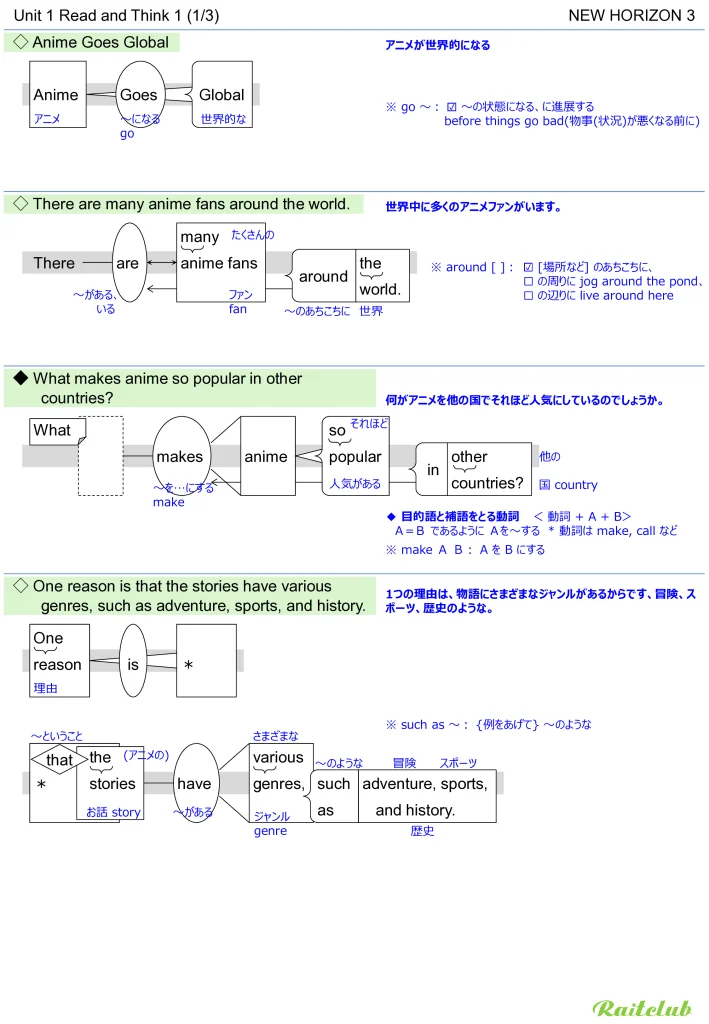
英文見える化チャート 2/3
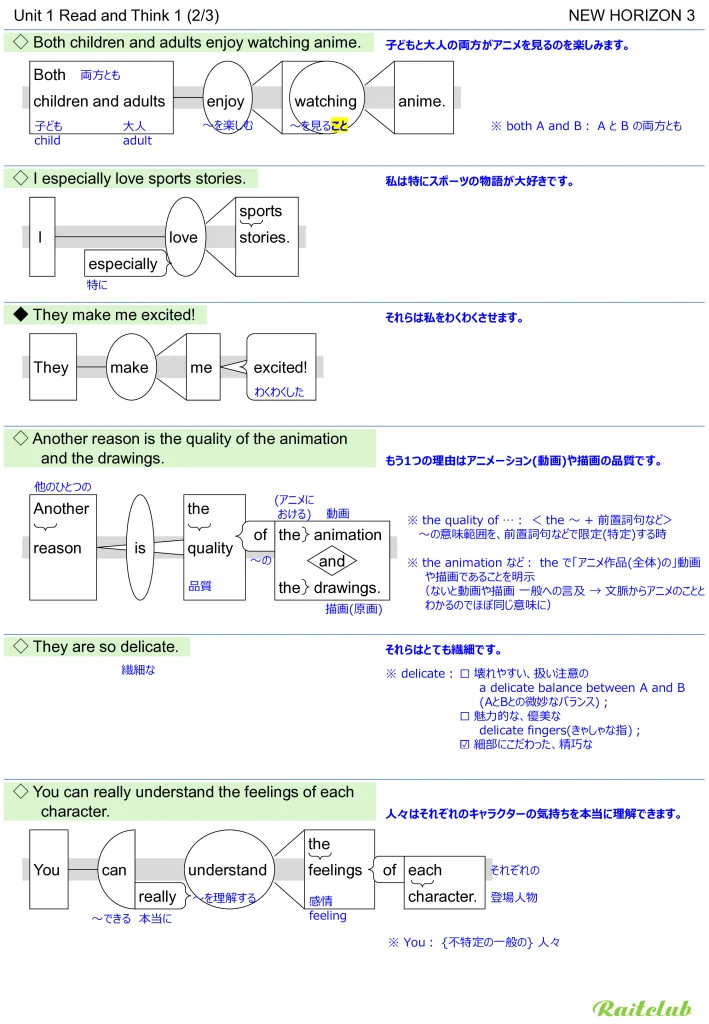
英文見える化チャート 3/3
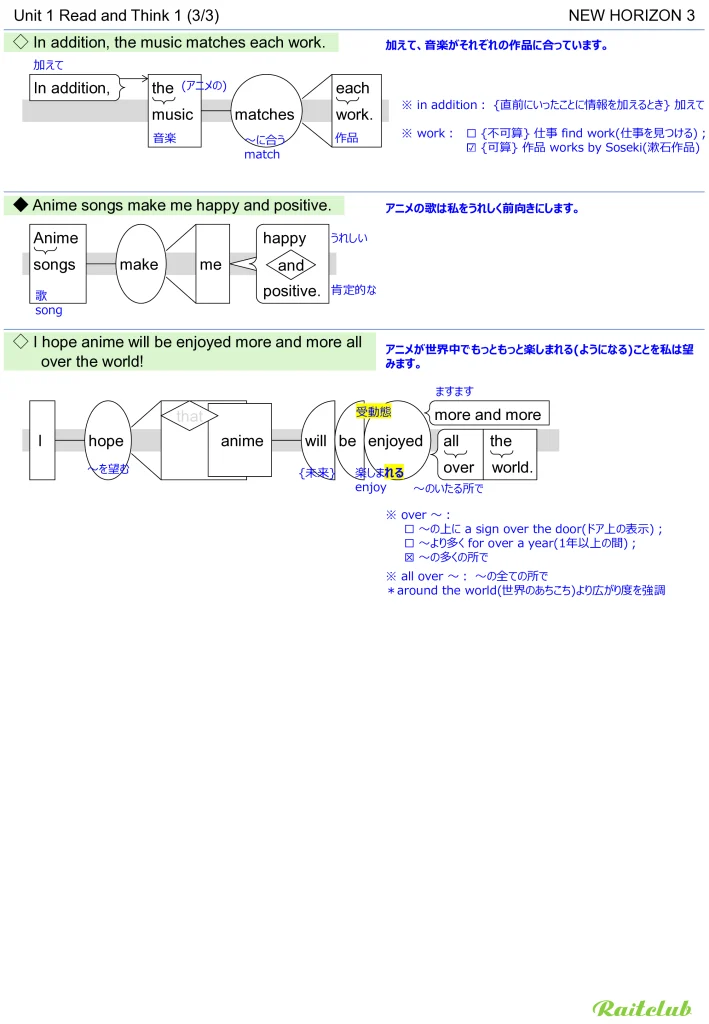
Unit 1 Read and Think 2
◇ When we talk about Japanese anime, we cannot ignore the existence of manga, the roots of anime.
私たちが日本のアニメについて話す時、アニメの起源であるマンガの存在を無視することはできません。
※ root: ☐ {植物などの} 根; ☒ {複数形で} 起源
*route(道、経路)とは無関係、発音は同じ
◇ It is said that the first Japanese manga was drawn over 800 years ago.
最初の日本のマンガは、800年よりも前に描かれたと言われています。
※ It is said that ~: ~と言われている
*It は形式的な主語、that 以下が本当の主語
=People [They] say that ~ .
◇ The artists expressed movement in picture scrolls.
その芸術家たちは絵巻物の中で動きを表現しました。
※ in [ ]: ☒ [本/映画など] の中で in the newspaper; ☒ [言語/表現様式など] で write in red ink ☆ ~の中
◇ These techniques were used by ukiyo-e artists, too.
これらの手法は浮世絵師によっても使われました。
補足) 動きの表現で浮世絵でも使われた技法として、水の表現やキャラの動きを表す効果線などがある
*細萱敦「絵巻物から絵草紙そしてマンガへの流れ」参照
◇ And they influenced Japanese anime.
そしてそれらが日本のアニメに影響を与えました。
◆ Anime shows us that Japanese pop culture comes from traditional culture.
日本のポップカルチャーは伝統的な文化から来ていることを、アニメは私たちに示しています。
◆ 目的語を2つとる動詞 < 動詞 + (人) + (that 節)>
(人)に(that 節であること)を~する * 動詞は show, tell, teachなど
◇ Look around and try to find other examples of new pop culture like anime.
周りに目をやり、アニメのような新しいポップカルチャーの他の例を、見つけようとしてみてください。
◇ How about matcha parfait?
抹茶パフェはどうでしょう。
◇ This is an example of new pop culture.
これは新しいポップカルチャーの例です。
◇ This sweet takes advantage of a traditional Japanese taste, matcha.
このスイーツは伝統的な日本の味、抹茶を利用しています。
※ advantage: 優位(であること)
※ take advantage of [ ]: ☒ [物・事] を利用する、活かす; ☐ [人] につけ込む(不当に扱う)
◇ I think pop culture is linked to traditional culture and becomes something entirely new.
ポップカルチャーは伝統的な文化と結びつき、全く新しい何かになる(ものだ)と私は思います。
※ A is linked to B:☐ {状態} AはBとつながれている、関係している; ☒ {動作} AはBとつながれる(結びつく)
* link A to B: ☐ AをBにつなぐ、関係づける link words to objects(単語を物と結びつける)
※ 受動態が{状態}か{動作}のどちらを表すかは文脈で判断
*ここではbecome(~に変化する)との整合で判断
※ something: 何か
修飾するには、形容詞を後ろに置く something cold
音声(英語/習得用)
| ♪ 英語の音声: | |
| 1回再生 | |
|---|---|
| ループ再生 | |
| ♪ 習得用の音声(英⇒日を区切りごと): | |
| 1回再生 | |
|---|---|
| ループ再生 | |
英文見える化チャート 1/3
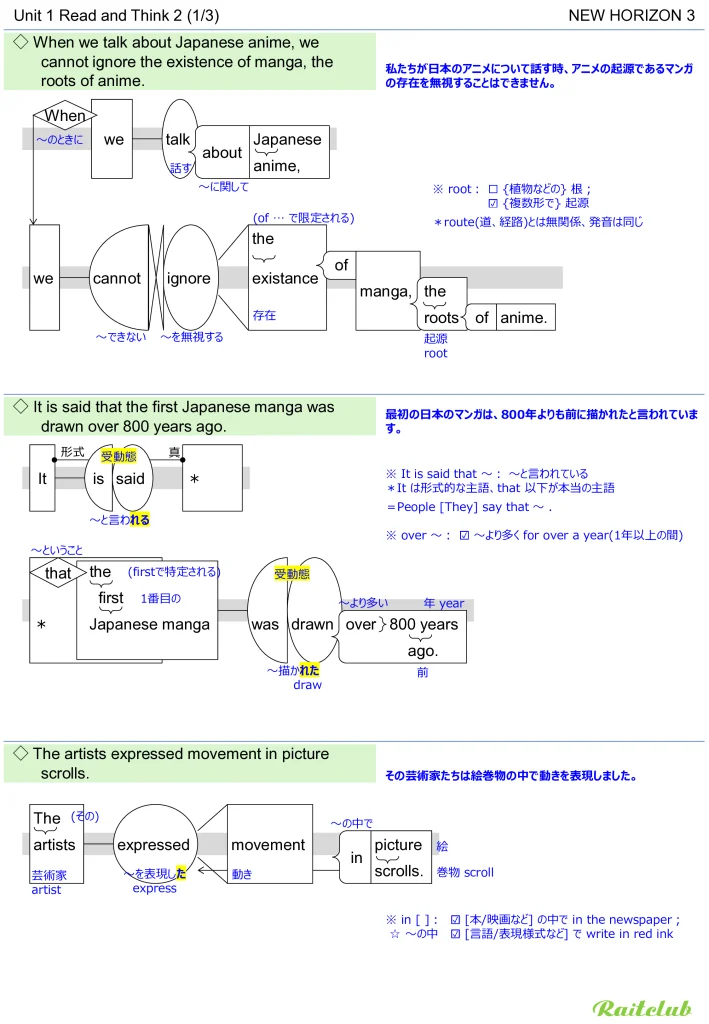
英文見える化チャート 2/3
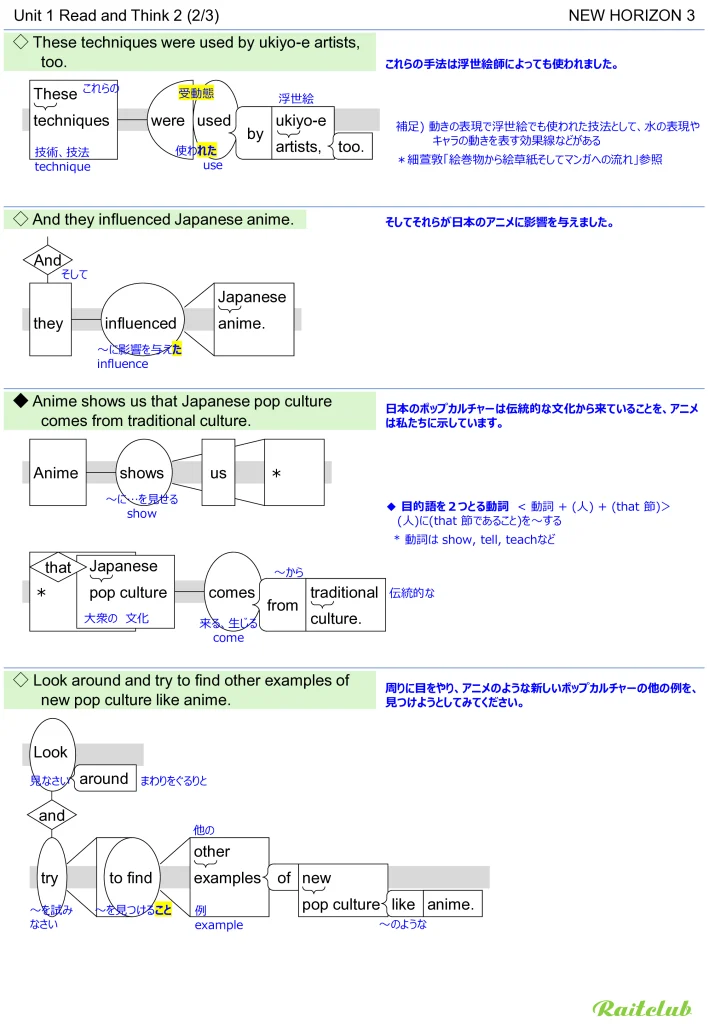
英文見える化チャート 3/3
